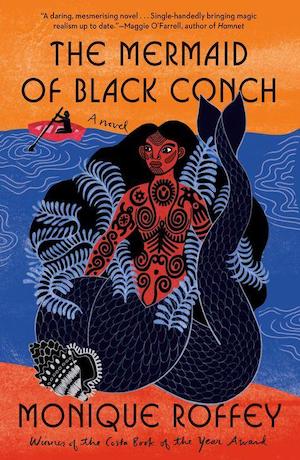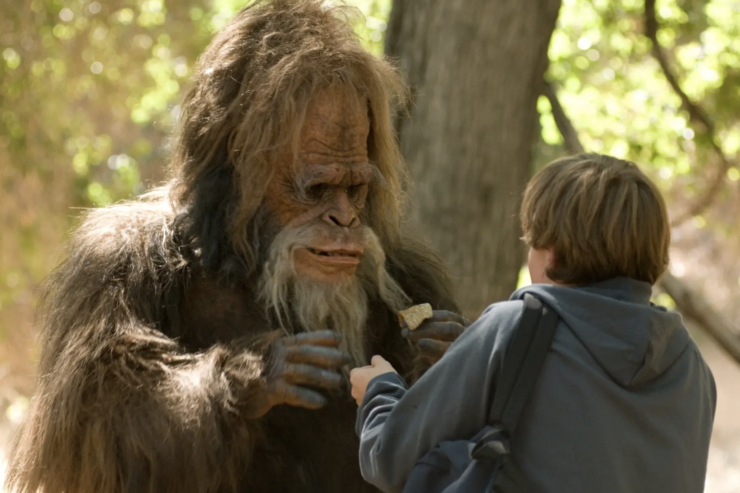I am a very hard sell on prose style. There are numerous authors whom I read for story and characters (and many of those are wonderful for both), but the prose makes my editor-fingers twitch. Others I can’t read at all: I bounce hard off the words.
But then there are the few in the perfect center. Story and characters—perfect. Prose—oh my.
Monique Roffey hits that center.
Just listen to this:
David Baptiste’s dreads are grey and his body wizened to twigs of hard black coral, but there are still a few people around St. Constance who remember him as a young man in the events of 1976, when those white men from Florida came to fish for marlin and instead pulled a mermaid out of the sea.
And this:
I saw the face of a human woman who once lived centuries past, shining at me. I saw she breasts, under the fine scaly suit. I saw webbed fingers and how they dripped with sargassum seaweed. Her hair was full of seaweed too, black black and long and alive with stinging creatures—like she carry a crown on her head of electricity wires. Every time she raise up her head I watch her hair fly up, like she ketch fire-coral inside it.
Or this:
I dream of my sisters
I dream my mother
I sleep and sleep and dream of long ago
I feel like I was in my dream
What was real?
What was dream?
This is a mermaid to end all mermaids. She comes from a legend of the Caribbean, the tale of Aycayia, the Sweet Voice, cursed by the women of her people to live forever in the shape of a woman with a fish’s tail. In Roffey’s world, she’s huge, terrifying; her tail is meters long, her teeth sharp, her hair full of deadly stinging sea-creatures.
There is only one of her. Legends tell of mermen in the waters in which she swims, but she has never met one. Her only companion is another cursed being, an old woman from her own village, transformed into a leatherback turtle.
There are echoes of the familiar Northern European stories. Aycayia is the youngest of seven sisters, but all of them were human. The other six died, drowned together before the curse fell on the youngest. As for the curse, it seems she was too alluring; the men all flocked to her, and the women got rid of her by transforming her into a mermaid and calling up a hurricane to sweep her out to sea.
There she lives for a thousand years, until she hears a young fisherman sitting in his boat, playing a guitar and singing hymns. She’s forgotten words by then, and apparently lost the ability to sing. David, the fisherman, falls in love. The mermaid’s feelings are less easily defined, but he fascinates her. She follows his boat when he goes out fishing.
That is her undoing. One day she follows the wrong boat, and snaps up the bait meant for a marlin. A rich American’s son hooks her and his father brings her in after an epic battle, to the shock of everyone on the boat.
Naturally her captors see her as a ticket to fame and, most particularly, fortune. But David rescues her and carries her off to his house, and keeps her hidden until the Americans give up and go away.
Here again the story touches on tradition. Aycayia, confined to the land, transforms gradually into a woman. Very gradually, literally step by step and piece by piece. Tail, scales, dorsal fin, all fall off and have to be carried away. She has to learn to walk again. She learns to talk—both speech itself and the language of the island. In the process she remembers her own long-dead language, and her long-dead people as well.
Part of that process involves learning another kind of language. The owner of most of the land and buildings on the island is a white woman, Arcadia Rain. Miss Rain’s son, Reggie, is deaf—one of the victims of the rubella epidemic of the Sixties—and he teaches Acayiyia American Sign Language. It’s through this that she finds her way back to spoken language.
Buy the Book


The Mermaid of Black Conch
The classic mermaid tale is a tale of love, and Roffey gives it its due. David loves the mermaid from the first. Aycayia discovers love as she learns to be a woman again after a thousand years.
But her curse is no plain or simple curse that dies with the one who casts it. Aycayia has been cursed forever. She can’t delude herself that this will be any more than an interlude. Every so often throughout her transformation, she hears the laughter of women on the wind. She knows it will come for her, and when it does, it will sweep everything else away.
The mermaid’s tale is at heart a tragedy. She wants what she can never have, or if she does succeed in getting it, she can’t keep it. She’s doomed to live between worlds, half woman, half fish, unable to live completely as either.
Aycayia the mermaid is immortal and physically powerful. She’s more whale than fish, to be strictly accurate: she breathes air, and she could conceivably drown if held underwater—though the curse would find a way, I’m sure, to keep her from dying. In her way she’s the personification of the sea in which she lives; she’s a goddess of sorts, Mama Wata as David calls her, the living embodiment of the African water spirit.
She is terribly lonely, and more so once she’s known love. And yet love and memory and the ability to write, which she gains from her five months on land with David and Reggie and Miss Rain, give her something precious to take with her into the rest of her endless life. I don’t think she regrets any of it, and maybe—maybe—she never forgets it.
Judith Tarr is a lifelong horse person. She supports her habit by writing works of fantasy and science fiction as well as historical novels, many of which have been published as ebooks. She’s written a primer for writers who want to write about horses: Writing Horses: The Fine Art of Getting It Right. She lives near Tucson, Arizona with a herd of Lipizzans, a clowder of cats, and a blue-eyed dog.














